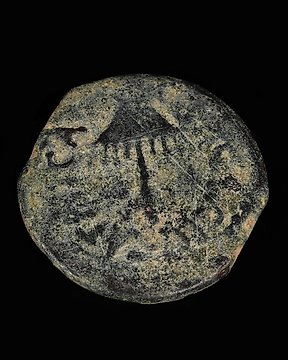
Romersk antik Bronze Provincial judæiske Prutah af Herodes Agrippa I (Ingen mindstepris)
Nr. 83896857

Nr. 83896857

Portrait Bust of a Youth.
- Masterpiece! -
- Museum Parallels -
Ancient Rome, Reign of Emperor Caracalla, c. 211 – 217 AD
Marble.
70 cm height.
PROVENANCE:
- Private collection, Europe. XIX Century.
- C. Mariani Antiques & Restoration, San Francisco, California, November 16, 2004 (Inv. No. M00571).
CONDITION: It is in very good condition, except for a small torn section at the rear right of the base and a similar small tear in his cloak at the rear left of the bust form, as well as at the center edge of his right ear.
DOCUMENTS:
- Study report on the antiquity of the piece issued by Dr. John Pollini. Professor of Classical Art, Archeology and History and Associate Professor of Art History in the Department of Art History at the University of Southern California in Los Angeles (USA).
BIBLIOGRAPHY:
- Fittschen, K., Zanker, P. Katalog der römischen Porträts in den Capitolinischen Museen und den anderen Kommunalen Sammlungen der Stadt Rom I: Kaiser- und Prinzenbildnisse. Mainz. 1985. pp. 105-112.
- Knauß, F.S., Gliwitzky, Z. (ed.), Charakterköpfe: Griechen und Römer im Porträt. Munich. 2017. pp.272-75, figs. 6.14, 6.16.
- Scholl, A. (ed.), Katalog der Skulpturen in der Antikensammulung der Staatlichen Museen zu Berlin I: Griechische und römische Bildnisse. Berlín. 2016. 148f.
DESCRIPTION:
This slightly over life-size marble bust of a handsome youth (total ht. 70 cm; ht. from chin to top of head 23.5 cm) is very well preserved except for a small broken off section on the right back side of the base and a similar small break on his mantle at the left back side of the bust form, as well as in the middle part of the rim of his right ear. The entire surface of the bust, which has a beige patina with brownish mottling, shows signs of weathering over its long history and strong cleaning in modern times. The mantle draped over his left shoulder is fastened with a large circular fibula (pin). Both mantle and pin indicate that he is a member of the upper class. The pupils of his eyes, now somewhat obscured by the weathered surface of the marble, were lightly drilled. His clumpy hairlocks are plastically carved.
The length of the bust form and the manner of the draping of the mantle over his left shoulder, the drilling of the pupils of his eyes, and his short clumpy hairstyle strongly suggest a date at the time of the Emperor Marcus Aurelius Antoninus, better known by his nickname Caracalla, who is similarly represented in many busts of this type. However, in his busts his head is represented as strongly averted to his proper left side, with a scowling facial expression, military style beard, and a sword belt slung around his right shoulder -- a look intended to project an image of a fearsome soldier emperor (cf. figs. 1-2 below).1 Although assassinated in 217 A.D., he was reluctantly deified by his successor Macrinus because of Caracalla’s great popularity with the Roman army.
The closest stylistic parallels for our bust of a youth of this period are several busts of the older, bare-chested Caracalla as sole emperor, with a hairstyle like that of our portrait and a bust form with mantle draped and pinned over his left shoulder in a very similar way. Providing perhaps the closest stylistic comparison of both the bust form and the carving of the marble for our youth is a high quality bust of Caracalla from Rome now in the Ancient Collections of the State Museums of Berlin (fig. 1-2).2 For the carving of the hairlocks another excellent comparative example is a little-known head of Caracalla in the Museum of Fine Arts in Houston (fig. 3).3 Our beardless youth imitates portraits of Caracalla in the way his short clumpy hairlocks are carved and in the lightly drilled pupils of his eyes. Stylistically, therefore, this bust of a youth should date about the time that Caracalla was sole emperor of Rome (211 – 217 A.D.).
PARALLELS:
Fig. 1 Bust of Emperor Caracalla. Roman Kingdom, reign of the Emperor. Marble. Antikensammlung, Berlin.
Fig. 2 Bust of Emperor Caracalla. Roman Kingdom, reign of the Emperor. Marble. Antikensammlung, Berlin.
Fig. 3. Portrait of Emperor Caracalla. Roman Kingdom, reign of the Emperor, 211 – 217 AD. Marble. 26 cm high. Museum of Fine Arts, Houston.
Notes:
The piece includes authenticity certificate.
The piece includes Spanish Export License (Passport for European Union) - If the piece is destined outside the European Union a substitution of the export permit should be requested. This process could take between 1 and 2 weeks.
#masterpieces
Sådan køber du hos Catawiki
1. Opdag noget særligt
2. Afgiv det højeste bud
3. Foretag en sikker betaling